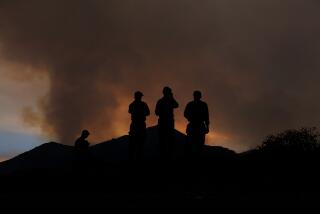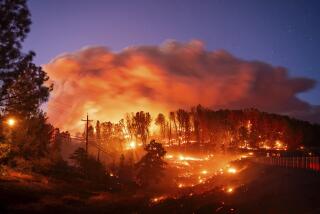80 Residences, 5,700 Acres Burn in Sierra Nevada
- Share via
SACRAMENTO — A wildfire raged through more than 5,700 acres of tinder-dry Sierra Nevada foothills north of the capital Sunday, sending hundreds fleeing and destroying or damaging at least 80 residences, both houses and mobile homes, as well as businesses.
California Department of Forestry spokesman John Ferreira was hopeful about prospects for controlling the fire: “It looks like things are very good . . . if the winds don’t pick up.” Full containment was expected by early Tuesday, the department said.
Gov. Pete Wilson was poised to declare the blackened foothills a state disaster area. Some evacuees were being allowed back into their communities, but hundreds were taking shelter at schools in Brownsville, said Department of Forestry spokeswoman Carol Gibson, who added that they likely would not be allowed back to their homes for at least two days.
Ferreira said the blaze began about 2:30 p.m. Saturday in a densely forested area about 50 miles from the state Capitol. It was sparked when a 1974 motor home’s generator shorted out.
By Sunday evening, authorities said the blaze was about 50% contained, as air tankers bombarded hot spots and ground crews fought the unpredictable winds and flames. More than 1,000 firefighters were battling the blaze, along with residents trying to save their homes.
The governor’s press secretary, Sean Walsh, said state officials estimated that thousands of acres had burned around the old gold mining town of Dobbins and the nearby outpost of Oregon House. Both are in Yuba County.
The fire was being dubbed the “Williams fire” because it evidently began on Williams Road in Dobbins, officials said.
Although these agricultural and lumber areas are sparsely populated, the foothill towns in recent years have been growing in population, with retirees and others moving from the state’s urban centers. As a consequence, forest fires now pose a much greater threat to homes and other buildings, as well as people and livestock.
Among the problems firefighters faced were inadequate water supplies and communication snafus because cellular telephones do not always operate smoothly in foothills, Walsh said.
Authorities said that as many as 1,000 people were forced to leave their homes. Many had to leave behind their pets and other animals, and some families were separated in the rush to reach safety.
One resident allowed to return Sunday was Joe Cardoza. He found that the fire had destroyed his small restaurant, auto shop and three houses in Oregon House.
“There’s nothing left. You can’t salvage it,” Cardoza said. “The fire took what it wanted to take.” He was watching the blaze from a safe distance when the wind shifted and the fire barreled down on the town.
“It created its own whirlwind, and then everything was on fire. It was just unbelievable,” he said.
Several miles away, in the town of Brownsville, Hal Houston, a contractor who once lived in Arcadia, also spent a sleepless night ready to leave at a moment’s notice.
“We were up all night. . . . It was an eerie sound as the propane tanks exploded. . . . We don’t have natural gas up here. We all have propane for our heating and cooking,” Houston said.
“We’re isolated in this town because we can’t get out and we can’t get anyone from the outside in,” Houston said. Adding to his frustration, Houston said, was that friends were calling from Missouri, and they knew more about the blaze from news reports than he did.
“We packed the car . . . but we haven’t put everything back. All it takes is a change in the wind direction. Things are very dry up Phere this time of year, extremely dry,” Houston said.
*
Some of those who left their homes wound up in the town of Loma Rica, where a thrift shop opened its doors to hand out clothes and other essential items to the displaced.
At the Loma Rica Community Church, people were beginning to trickle into an evacuation center. “We’ll open up. We’ll be here until this thing is over,” said David Rice, a youth pastor. “This morning we had ash all over our vehicles and the church,” he said.
The National Weather Service reported that residents elsewhere in Northern California might notice a thin layer of smoke overhead. The service said satellite pictures indicated that the plume of smoke had spread southwest, across San Francisco Bay and out over the Pacific Ocean.
A number of wilderness fires have scorched Southern California acreage in recent months as the long, dry season turns brush into ready fuel.
One burned for nearly 11 days in the Angeles National Forest northeast of Azusa, threatening the resort town of Wrightwood.
Nicknamed the “Charmin fire” by locals because hikers burning toilet paper started it, the August blaze destroyed nearly 18,000 acres in an area that had not burned since 1953.
Although the town choked on smoke for days, it was spared and no buildings were lost.
Some 19,000 acres were blackened near Lake Piru in Ventura County last month while another fire east of Santa Maria along the Santa Barbara-San Luis Obispo county line charred nearly 60,000 acres.
*
Times staff writer Bettina Boxall and Associated Press contributed to this story.
More to Read
Sign up for Essential California
The most important California stories and recommendations in your inbox every morning.
You may occasionally receive promotional content from the Los Angeles Times.










